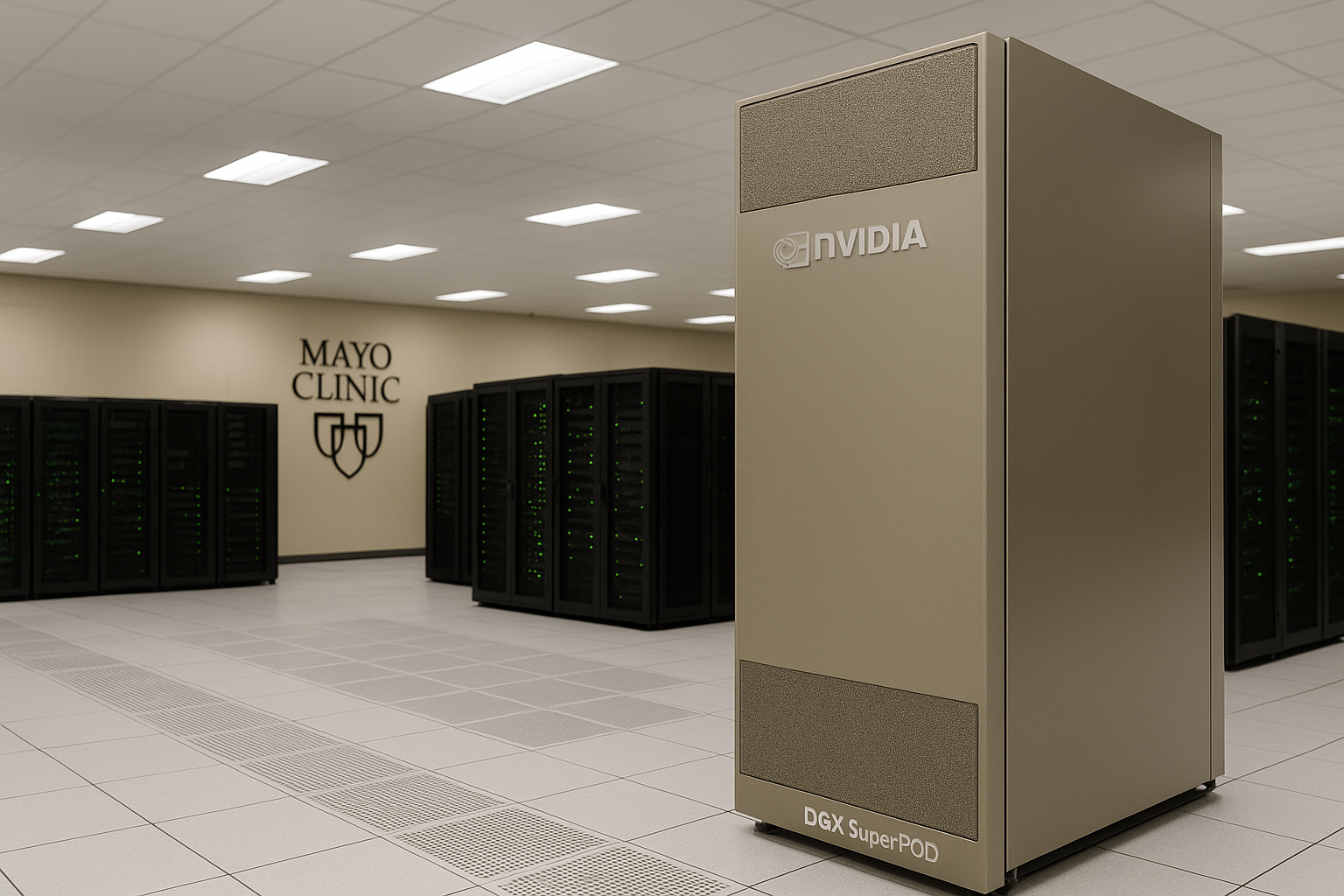When it comes to transforming healthcare with artificial intelligence, few innovations rival the NVIDIA SuperPOD at Mayo Clinic. In a world where early detection can mean the difference between life and death, this cutting edge supercomputing system is enabling faster diagnostics, hyper personalized treatments, and groundbreaking drug discovery all in record time.
This move aligns with Mayo Clinic’s Bold. Forward. strategy, fusing generative AI with digital pathology to create a new era of precision medicine. The impact? A healthcare future where each patient’s treatment plan is as unique as their DNA.
The NVIDIA SuperPOD is not just a bigger computer it’s an entire ecosystem of AI powered computation, capable of training and running massive models at speeds traditional systems could never achieve. For Mayo Clinic, this means.
Real time pathology analysis reading cell images at lightning speed
Accelerated drug discovery testing thousands of compounds virtually before a single lab experiment. Foundational models for pathomics building AI that understands disease at a microscopic level
True precision medicine tailoring treatments based on an individual’s biological and genetic makeup. This leap in infrastructure gives doctors the ability to move from symptom based medicine to predictive and preventive care.
Before NVIDIA SuperPOD, certain cancer diagnoses took several days as pathologists examined slides under a microscope. In a recent Mayo Clinic pilot study, AI driven pathology analysis reduced this process to just three hours.
Dr. Emily Harrison, a senior pathologist at Mayo Clinic, shared. With SuperPOD’s AI models, we can detect subtle cellular changes that even trained eyes might miss. This gives us a head start in initiating treatment, which can drastically improve patient survival rates.
The AI system not only detects abnormalities but also suggests likely subtypes, giving doctors more data to work with from the start.
The Technology Behind the Breakthrough
The NVIDIA SuperPOD is powered by DGX systems massive GPU clusters optimized for AI workloads. In healthcare, these GPUs are perfect for training complex models such as.
Generative AI for medical imaging creating synthetic but accurate examples for rare diseases. Large language models for healthcare data summarizing patient histories and research findings instantly
Drug discovery algorithms running billions of simulations to find the most promising treatments. Because it’s scalable, the SuperPOD can handle thousands of tasks simultaneously, from analyzing biopsy slides to modeling protein structures.
Why This Matters for Drug Discovery
Pharmaceutical researcher Dr. Jacob Lin believes NVIDIA SuperPOD could cut drug development time in half. Traditional drug trials take years and billions of dollars. AI simulation allows us to eliminate dead ends before we even start physical experiments.
The result is faster delivery of safe, effective drugs to patients who need them most. This shift means future pandemics could be addressed with targeted treatments in months, not years.
How AI Saved My Father’s Life
Last year, my father was diagnosed with an aggressive form of lung cancer. By pure luck, he was part of a trial at Mayo Clinic using AI assisted pathology. Within hours, doctors knew the exact tumor type and recommended a targeted therapy that had just been approved.
The speed of diagnosis powered by NVIDIA SuperPOD meant treatment started almost immediately. Today, he is in remission. Without AI, we might have lost weeks waiting for lab results, and those weeks could have made all the difference.
Hyper Personalized Medicine: More Than a Buzzword
The term hyper personalized medicine often sounds like marketing jargon, but at Mayo Clinic, it’s becoming reality. With NVIDIA SuperPOD, AI can integrate. Genomic data identifying mutations that influence drug response
Lifestyle data adjusting treatment plans for diet, activity, and environment. Historical patient data learning from similar cases to predict treatment outcomes. The end goal is a treatment roadmap unique to each patient, not a one size fits all prescription.
While the potential is enormous, experts caution about bias in AI models. Dr. Maria Sanchez, an AI ethics specialist, explains. If training data isn’t diverse, AI can make flawed recommendations. Mayo Clinic is taking steps to ensure their models are trained on varied, representative datasets to avoid these pitfalls.
Another challenge is data privacy. Supercomputers like NVIDIA SuperPOD require vast amounts of medical data, which must be protected with the highest cybersecurity standards.
Why This Is a Paradigm Shift
The deployment of NVIDIA SuperPOD at Mayo Clinic isn’t just a tech upgrade it’s the start of a paradigm shift in healthcare. From reactive to proactive medicine Detecting disease before symptoms appear, From population based to individual based care Customizing every treatment
From slow to real time research Turning decades of studies into instant insights. This mirrors transformations seen in other industries when AI was introduced but with much higher stakes, because here, lives are on the line.
Looking ahead, Mayo Clinic plans to expand NVIDIA SuperPOD’s capabilities into, Remote AI diagnostics for rural and underserved areas. Virtual clinical trials using AI patient models, AI powered patient education for better treatment adherence.
The convergence of AI, big data, and human expertise could create a healthcare system where disease prevention is the norm, not the exception.
A New Era of Healing
The integration of NVIDIA SuperPOD into Mayo Clinic’s medical ecosystem signals the dawn of a new era in medicine one where diagnosis is instant, treatments are hyper personalized, and research breakthroughs happen at unprecedented speeds.
For patients, this means hope where there was uncertainty. For doctors, it’s the ability to act with more precision than ever before. And for the future of healthcare, it’s proof that when human compassion meets AI power, the possibilities are limitless.

